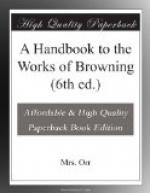[Footnote 38: Figures placed above the entrance of Athenian houses, and symbolizing the double life. It was held as sacrilege to deface them, as had been recently and mysteriously done.]
[Footnote 39: Introducing him into the play, as in the disguise of a disreputable woman.]
[Footnote 40: Aristophanes’ comedy of the “Clouds” was written especially at Socrates, who stood up unconcernedly in the theatre that the many strangers present might understand what was intended.]
[Footnote 41: Mr. Mahaffy’s description of the “Clouds” contains an account of this defeat, which sets forth the amusing conceit and sophistry of Aristophanes’ explanation of it. He alludes here to the prevailing custom of several dramatic writers competing for a prize.]
[Footnote 42: Whirligig is a parody of the word “vortex.” Vortex itself is used in derision of Socrates, who is represented in the “Clouds” as setting up this non-rational force in the place of Zeus—the clouds themselves being subordinate divinities.]
[Footnote 43: Saperdion was a famous Hetaira, the Empousa, a mythological monster. Kimberic or Cimberic means transparent.]
[Footnote 44: A pure libel on this play, which is noted for its novel and successful attempt to represent humour without indecency. Aristophanes here alludes to the prevailing custom of concluding every group of three tragedies with a play in which the chorus consisted of Satyrs: a custom which Euripides broke through.]
[Footnote 45: The inverted commas include here, as elsewhere in the Apology, only the very condensed substance of Mr. Browning’s words.]
[Footnote 46: Tin-islands. Scilly Islands, loosely speaking, Great Britain.]
[Footnote 47: A demagogue of bad character attacked by Aristophanes: a big fellow and great coward.]
[Footnote 48: White was the Greek colour of victory. This passage, not easily paraphrased, is a poetic recognition of the latent sympathy of Aristophanes with the good cause.]
[Footnote 49: A game said to be of Sicilian origin and played in many ways. Details of it may be found in Becker’s “Charikles,” vol. ii.]
[Footnote 50: Thamyris of Thrace, said to have been blinded by the Muses for contending with them in song. The incident is given in the “Iliad,” and was treated again by Sophocles, as Aristophanes also relates.]
[Footnote 51: This also is historical.]
[Footnote 52: Grote’s “History of Greece,” vol. iii. p. 265.]
[Footnote 53: Eidothee or Eidothea, is the daughter of Proteus—the old man of the sea. A legend concerning her is found in the 4th book of the Odyssey.]
[Footnote 54: There is such a monument at Pornic.]
[Footnote 55: These words are taken from a line in the Prometheus of AEschylus.]
[Footnote 56: Mr. Browning desires me to say that he has been wrong in associating this custom with the little temple by the river Clitumnus which he describes from personal knowledge. That to which the tradition refers stood by the lake of Nemi.]




